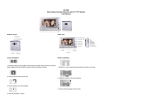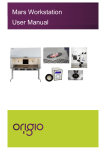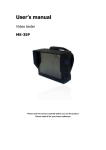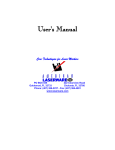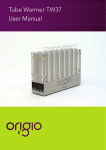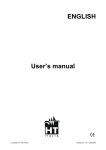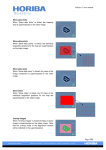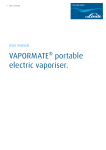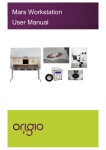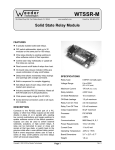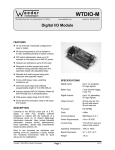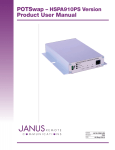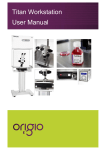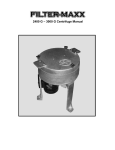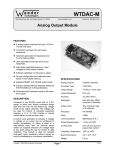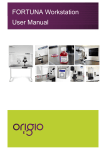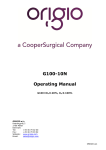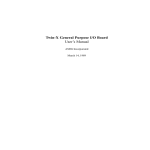Download WP37 & HT37 User Manual
Transcript
WP37 & HT37 User Manual Origio WP37 & HT37 Warming Plates & Heated Trolley Warming Plates WP37 300 WP37 500 Heated Trolley HT37 Origio WP37 Component Description Heated work surface Power supply and temperature controller Model WP37 300 Model WP37 500 Origio HT37 Component Description Page 2 of 13 WP37 Warming Plate & HT37 Heated Trolley User Manual _ Ver. 2.0 Heated work surface Temperature controller Controls for height adjustment Side shelf Three integrated power sources Four lockable wheels Temperature controller Component Description Actual temperature DISPLAY OFF Controller in standby OR Probe T1 out of range or failure HI Room high temperature alarm LO Room low temperature alarm TUN Controller in autotuning E1 In tuning: Timeout1 error E2 In tuning: Timeout2 error E3 In tuning: Out of range error INDICATION OUT1 Channel 1 output OUT2 Channel 2 output L1 Channel 1 setpoint modification L2 Channel 2 setpoint modification Alarm INFORMATION THI Maximum temperature recorded TLO Minimum temperature recorded LOC Keypad state lock Page 3 of 13 WP37 Warming Plate & HT37 Heated Trolley User Manual _ Ver. 2.0 TABLE OF CONTENTS 1 2 2.1 2.2 3 3.1 3.1.1 3.1.2 3.2 3.2.1 3.2.2 3.3 3.4 3.4.1 3.4.2 3.4.3 3.4.4 3.4.5 4 4.1 4.1.1 4.1.2 4.1.3 4.1.4 4.1.5 4.2 4.2.1 4.2.2 4.2.3 4.2.4 4.3 4.4 4.5 5 5.1 5.2 5.3 5.3.1 5.3.2 6 GENERAL INFORMATION ............................................................................................................... 5 IMPORTANT INFORMATION ........................................................................................................... 5 Safety Information .............................................................................................................................. 5 Operational Characteristics ................................................................................................................ 5 PRODUCT OVERVIEW ..................................................................................................................... 5 Product Hardware Description ........................................................................................................... 5 Warming plates WP37........................................................................................................................ 5 Heated trolley HT37 ........................................................................................................................... 7 Product Operation description ............................................................................................................ 9 WP37 warming plates ........................................................................................................................ 9 HT37 heated trolley ............................................................................................................................ 9 Product Performance Description ...................................................................................................... 9 The parameters 1PB, 1IT, 1DT, 1AR and 1CT ................................................................................ 10 Proportional bandwidth (1PB) .......................................................................................................... 10 Integral action time (1IT) .................................................................................................................. 10 Derivative action time (1DT) ............................................................................................................. 10 Reset of integral action time referred to 1PB (1AR)......................................................................... 10 Cycle time (1CT) .............................................................................................................................. 10 USER SETUP .................................................................................................................................. 10 Accessing the parameters ................................................................................................................ 10 Accessing the information menu ...................................................................................................... 10 Reset the THI and TLO recordings .................................................................................................. 11 Channel 1 setpoint ........................................................................................................................... 11 Standby ............................................................................................................................................ 11 Keypad lock ...................................................................................................................................... 11 Controller autotuning in PID mode ................................................................................................... 11 Before starting .................................................................................................................................. 11 Start autotuning ................................................................................................................................ 11 During autotuning ............................................................................................................................. 11 Errors ................................................................................................................................................ 11 Accessing the factory set operating parameters .............................................................................. 12 Determining the offset ...................................................................................................................... 12 Temperature variation ...................................................................................................................... 13 OPERATING THE WP37 WARMING PLATES AND HT37 HEATED TROLLEY .......................... 13 Normal operation .............................................................................................................................. 13 Checking the temperature ................................................................................................................ 13 Cleaning the work surface and control unit ...................................................................................... 13 Surface cleaning............................................................................................................................... 13 Control box ....................................................................................................................................... 13 TECHNICAL SPECIFICATION ........................................................................................................ 13 Page 4 of 13 WP37 Warming Plate & HT37 Heated Trolley User Manual _ Ver. 2.0 1 GENERAL INFORMATION This manual contains information that is subject to copyright. All rights reserved. This manual should not be photocopied, otherwise copied or distributed, completely or in part, without the approval of ORIGIO ScanLab Equipment A/S. There are no user serviceable parts in either the controller or warming plate or the trolley and any service problems must be referred to Origio ScanLab Equipment. The units are designed to be powered from a mains electricity supply (check rear of unit for operating voltage) and it must be earthed via the incoming mains lead. 2 IMPORTANT INFORMATION 2.1 Safety Information Before use the warming plates must be placed on a level and reasonably heat resistant surface. Before use the heated trolley must be placed on a level surface preferably with little to no traffic around it and the castors should be locked. Be aware of the power cord for the trolley. Appropriate securing and marking of the power cord must be assured for personnel safety. 2.2 Operational Characteristics The warming plates and the top working surface on the heated trolley (they are essentially identical units) will warm to 37 ºC and is controlled by an accurate sensor and control processor. Placing of large hot or cold masses on the heated elements will affect the regulation process and should be avoided during normal operation. Placing a hand will also draw heat from the surface therefore please avoid placing fingers or a hand on the surface during warming up or during calibration of the controller. Turn on the heating system at least 30 minutes before starting the work. If possible place all needed equipment on the surface during the warming up period to warm these appropriately. Always wait for the temperature to stabilize completely before starting work. 3 PRODUCT OVERVIEW 3.1 Product Hardware Description 3.1.1 Warming plates WP37 The WP37 System consists of a separate control unit, a power cord for said unit, the heated plate module made from heated anodised aluminium and interconnecting cable between the heated plate and the control unit. The control unit consists of a free standing cabinet containing the controller with display and operator interface. The heat is generated by one (WP37 300) or two (WP37 500) mat type heating elements build into the warming plate. The mats are self-adhesive and have etched foil elements embedded into a glass cloth supported rubber compound. Each mat is powered by 230 VAC and has a power rating of 100 W. Power supply for the heated mats is supplied via cable from the control unit. The actual temperature is measured by a class B standard PT100 element embedded in the warming plate. A signal is feed to the temperature controller as input for regulation via a cable. Page 5 of 13 WP37 Warming Plate & HT37 Heated Trolley User Manual _ Ver. 2.0 The cables between the warming plate and the control unit as well as the power cable for the control unit are all fixed. Heating mat PT 100 element PT100 cable Power cable The temperature controller that regulates and maintains a stable temperature on the warming plate during normal operation is shown below. Thee display shows the temperature readout from the chosen channel (only channel 1 is used on this application). In case of an alarm situation a red light will start flashing in the top left-hand corner of the display. On the right-hand side of the display it is indicated which parameter is shown in the display. Below is listed all possible values and messages that can be shown in the display: DISPLAY INDICATION OFF Controller in standby OUT1 Channel 1 output OR Probe T1 out of range or failure OUT2 Channel 2 output HI Room high temperature alarm L1 Channel 1 setpoint modification LO Room low temperature alarm L2 Channel 2 setpoint modification TUN Controller in autotuning E1 In tuning: Timeout1 error E2 In tuning: Timeout2 error THI Maximum temperature recorded E3 In tuning: Out of range error TLO Minimum temperature recorded LOC Keypad state lock Alarm INFORMATION Page 6 of 13 WP37 Warming Plate & HT37 Heated Trolley User Manual _ Ver. 2.0 Standby Exit Modify setpoint 2 Increase value Decrease value Modify setpoint 1 Enter Information Below the display the four buttons for operating the temperature controller is placed: Each button has two functions - one in each end of the button. Simply press the appropriate symbol to use the buttons. 3.1.2 Heated trolley HT37 The HT37 heated trolley consists of a heated table top made from heated anodised aluminium, a control unit mounted just below the working surface, a motorized column for adjusting the height of the working surface, controls for said column, a side shelf, three build in power sources and finally four lockable castors for mobility. The control unit consists of a fixed mounted cabinet containing the controller with display and operator interface. The heat is generated by three mat type heating elements build into the heated table top of the trolley. The mats are self-adhesive and have etched foil elements embedded into a glass cloth supported rubber compound. Each mat is powered by 230 VAC and has a power rating of 267 W. Power supply for the heated mats is supplied via cable from the control unit. The actual temperature is measured by a class B standard PT100 element embedded in the working surface of the heated trolley. A signal is feed to the temperature controller as input for regulation via a cable. The cables between the warming plate and the control unit are fixed while the power cable for the entire trolley is detachable. The table top is connected to the base through a column made from a 2-piece anodized aluminium profile with integrated actuator. The travel length of the column is 300 mm and it is capable of lifting approximately 50 kg. The height adjusting mechanism is controlled by a very simple and easy to use two-button interface: Arrow-up to elevate the table top and arrow-down to lower the table top. Page 7 of 13 WP37 Warming Plate & HT37 Heated Trolley User Manual _ Ver. 2.0 850 mm Side shelf 1250 mm Controls for height The side shelf mounted under the table top is designed as an easy way to store equipment used during the work processes without taking up space on the table top. The three build-in power sources are protected by lids, when not in use. They are rated IP44. For mobility the trolley is equipped with four easy-rolling castors. Fore safety during work the castors are all equipped with brakes to ensure that the trolley is stationary during use. Always remember to engage the brakes before starting work. The temperature controller that regulates and maintains a stable temperature on the warming plate during normal operation is shown below. Thee display shows the temperature readout from the chosen channel (only channel 1 is used on this application). In case of an alarm situation a red light will start flashing in the top left-hand corner of the display. On the right-hand side of the display it is indicated which parameter is shown in the display. Below is listed all possible values and messages that can be shown in the display: DISPLAY INDICATION OFF Controller in standby OUT1 Channel 1 output OR Probe T1 out of range or failure OUT2 Channel 2 output HI Room high temperature alarm L1 Channel 1 setpoint modification LO Room low temperature alarm L2 Channel 2 setpoint modification TUN Controller in autotuning Alarm Page 8 of 13 WP37 Warming Plate & HT37 Heated Trolley User Manual _ Ver. 2.0 INFORMATION E1 In tuning: Timeout1 error E2 In tuning: Timeout2 error THI Maximum temperature recorded E3 In tuning: Out of range error TLO Minimum temperature recorded LOC Keypad state lock Standby Exit Modify setpoint 2 Increase value Decrease value Modify setpoint 1 Enter Information Below the display the four buttons for operating the temperature controller is placed: Each button has two functions - one in each end of the button. Simply press the appropriate symbol to use the buttons. 3.2 Product Operation description 3.2.1 WP37 warming plates On power up the temperature controller is turned on and the heating elements start warming up immediately. The factory setpoint temperature is 37 °C. If a different temperature is needed, the setpoint must be changed. For details, see below. Before starting work the temperature of the warming plate must be stabilized. Warming up time will depend on what equipment is placed on the warming plate during warm up. The temperature is stabilized when the display shows the correct temperature (the setpoint temperature) and stays within ± 0,1 °C of this. Calculate with at le ast 30 minutes to 1 hour to be sure. Make sure that it is the value for OUT1 that is displayed. 3.2.2 HT37 heated trolley The same description as above applies. The height adjustment system is ready for use as soon as the power is turned on. 3.3 Product Performance Description The warming plates WP37 300 and WP37 500 and the heated trolley HT37 are all designed to provide and maintain a constant 37 °C over the heated part of t he working surfaces to within ± 0,2 °C at a maximum ambient temperature of 36 °C. The controller is operating in PID (Proportional-Integral-Derivative) mode to get the most accurate and stable temperature possible. When running in PID mode the parameters 1PB, 1IT, 1DT, 1AR, 1CT will be used. Page 9 of 13 WP37 Warming Plate & HT37 Heated Trolley User Manual _ Ver. 2.0 3.4 The parameters 1PB, 1IT, 1DT, 1AR and 1CT 3.4.1 Proportional bandwidth (1PB) Temperature control takes place by changing the ON time of the output: the closer the temperature to the setpoint, the less time of activation. A small proportional band increases the promptness of response of the system to temperature variations, but tends to make it less stable. A purely proportional control stabilises the temperature within the proportional band but does not cancel the deviation from setpoint. The value of this parameter must be verified by an “autotuning”. See below. 3.4.2 Integral action time (1IT) The steady-state error is cancelled by inserting an integral action. The integral action time, determines the speed with which the steady-state temperature is achieved, but a high speed (1IT low) may be the cause of overshoot and instability in the response. The value of this parameter must be verified by an “autotuning”. See below. 3.4.3 Derivative action time (1DT) Response overshoot may be reduced by inserting a derivative Action. A high derivative action (1DT high) makes the system very sensitive to small temperature variations and causes instability. The value of this parameter must be verified by an “autotuning”. See below. 3.4.4 Reset of integral action time referred to 1PB (1AR) Decreasing the parameter 1AR reduces the integral control action zone, and consequently the overshoot (see figure in paragraph 1IT). The value of this parameter must be verified by an “autotuning”. See below. 3.4.5 Cycle time (1CT) It’s the period in which the output ON time changes. The quicker the system to be controlled reacts to temperature variations, the smaller the cycle time must be, in order to obtain higher temperature stability and less sensitivity to load variations. 4 USER SETUP Generally the units are delivered ready for use from the factory. Should it be necessary to access the parameters in the temperature controller, this is how it is done: 4.1 Accessing the parameters 4.1.1 Accessing the information menu o Press and immediately release button . Page 10 of 13 WP37 Warming Plate & HT37 Heated Trolley User Manual _ Ver. 2.0 o o o With button or select the data to be displayed. Press button to display value. To exit from the menu, press button or wait for 10 seconds. 4.1.2 Reset the THI and TLO recordings o o o With button or select the data to be reset. Display the value with button . While keeping button pressed, use button . 4.1.3 Channel 1 setpoint o o o Press and release button : the LED L1 blinks, the display shows 1SP for 1 second and then the setpoint associated value. Press buttons or to set the desired value (adjustment is within the minimum SPL and maximum SPH limit). To store the new value press button , or wait for 10 seconds. To go back to normal mode without saving the new value, press . 4.1.4 Standby o Button , when pressed for 3 seconds, allows the controller to be put on a standby or output control to be resumed (with SB=YES only). 4.1.5 Keypad lock The keypad lock avoids undesired, potentially dangerous operations, which might be attempted when the controllers is operating in a public place. In the INFO menu, set parameter LOC=YES to inhibit all functions of the buttons. To resume normal operation of keypad, adjust setting so that LOC=NO. 4.2 Controller autotuning in PID mode This operation should only be performed by a trained technician during service or re-calibration. 4.2.1 Before starting In the setup mode (see configuration parameters): set 1CM=PID; make sure that 1CH matches the desired operation mode (1CH=REF for refrigerating control, 1CH=HEA for heating control); then adjust setpoint 1SP at the desired value. 4.2.2 Start autotuning During normal operation, keep buttons + pressed for 3 seconds. 1CT blinks on the display. With + or set the cycle time in order to define the dynamic of the process to be controlled. To abort the autotuning function, press ; to start autotuning press + or wait for 30 seconds. 4.2.3 During autotuning During the entire autotuning phase, the display alternates TUN with the actual temperature measured. In case of power failure, when power is resumed, after the initial auto test phase, the controller resumes the autotuning function. To abort the autotuning, without modifying the previous control parameters, keep button pressed for 3 seconds. After the autotuning has taken place successfully, the controller updates the control parameters and starts to control. 4.2.4 Errors If the autotuning function failed, the display shows an error code: o E1 timeout1 error: the controller could not bring the temperature within the proportional band. Increase 1SP in case of heating control, vice versa, decrease 1SP in case of refrigerating control and re-start the process. Page 11 of 13 WP37 Warming Plate & HT37 Heated Trolley User Manual _ Ver. 2.0 o E2 timeout2 error: the autotuning has not ended within the maximum time allowed (1000 cycle times). Re-start the autotuning process and set a longer cycle time 1CT. E3 temperature out of range: check that the error was not caused by a probe malfunction, then decrease 1SP in case of heating control, vice versa increase 1SP in case of refrigerating control and then re-start the process. To eliminate the error indication and return to the normal mode, press button . 4.3 Accessing the factory set operating parameters o o Before the temperature controller can be used, a number of parameters must be set and the displayed temperature calibrated. This is done at the factory before delivery. It is not advisable to change any of the parameters mentioned in this paragraph. Start the process by turning on the temperature controller and wait until the heated area on the work surface has reached the set temperature – factory setting is 37 °C – and the temperature reading has stabilize d. To enter the parameter configuration menu follow the procedure below: To get access to the parameter configuration menu, press button + for 5 seconds. With button or select the parameter to be modified. Press to display the existing parameter value. By keeping pressed, use button or to set the desired value. When is released, the newly programmed value is stored and the next parameter is displayed. To exit from the setup, press or wait for 30 seconds. o o o o o o In the table below are listed all the parameters that are not the temperature controller manufacturers default values. These parameters has been changed or set at the factory before delivery Parameter Value SCL Parameter Value 1 1CT 1 SPL 0 1PF OFF SPH 50 OAU NON 1SP 37 ATM NON 1CM PID SB YES 1CH HEA OS1 X,X 1PB 3,0 To be verified by an “autotuning”. TLD 0,5 1IT 209 To be verified by an “autotuning”. SIM 0,5 1DT 44 To be verified by an “autotuning”. ADR 1 1AR 50 To be verified by an “autotuning”. 4.4 Remarks Remarks Calibration offset. Determining the offset OS1: This is the offset between the displayed temperature and the actual temperature on the work surface. The value is calculated as the difference between the measured and the displayed temperature OS1 = TM TD (= 35,7 - 37,0 = -1,3). After entering the calculated offset make a check measurement of the accuracy of the calibration. The difference between the displayed and measured should be within ± 0,1 °C. To determine the value of TD the following procedure should be followed: Page 12 of 13 WP37 Warming Plate & HT37 Heated Trolley User Manual _ Ver. 2.0 The heated zone on the work surface of the warming plates and the heated trolley are one, two or three rectangular areas corresponding to the number of heated mats on the particular unit. As only one offset value can be entered in controller, the average temperature measured centrally on each of the heated mat areas is used for the calculation of the offset. The temperature is measured in the appropriate measuring positions using type k (or equal) thermocouples and a suitable thermometer with 0,1 °C resolution. The thermometer including the thermocouple(s) must be calibrated, as the set point temperature calibration is an absolute temperature calibration. To ensure good thermal contact between the thermocouple and the work surface, the exposed end of the thermocouple must be fastened to the work surface using aluminium tape or equal. Calculate the average measured temperature and from this value the value of OS1. Enter this value in the controller. 4.5 Temperature variation To determine the temperature variation over the heated surface use the method and equipment described above. On each mat six evenly spread positions is measured and the difference between the highest and the lowest value measured gives the variation. Make sure, that all measurement positions are within the area covered by the heated mats. 5 OPERATING THE WP37 WARMING PLATES AND HT37 HEATED TROLLEY 5.1 Normal operation Once the controller is setup correctly it will maintain the work surface temperature at 37 °C and will not require any further interaction. 5.2 Checking the temperature The actual temperature of the surface is displayed on the display (OUT1) and will also show the setpoint temperature L1. 5.3 Cleaning the work surface and control unit Before cleaning make sure the power is off and the cord removed from the supply. 5.3.1 Surface cleaning The work surface must not be cleaned with abrasives of any kind. Use normal mild detergents or an alcohol based cleaner. Always clean using a soft cloth. 5.3.2 Control box The control box can cleaned with a soft cloth only, no liquids of any kind and only when the unit is isolated from the mains supply. 6 TECHNICAL SPECIFICATION o o o o o o o Power Input, 220-240 VAC, 50-60 Hz via an IEC lead Fuse protection, minimum 5A A/C (WP37) and 13A A/C (HT37) Operating temperature 37 °C Calibration Method, Offset Warm up to quiescence = 30 minutes to 1 hour Earthed chassis with 3 wire mains lead The temperature accuracy (maintained by the PT100 sensor) is ± 0,2 °C at 37 °C Page 13 of 13 WP37 Warming Plate & HT37 Heated Trolley User Manual _ Ver. 2.0













